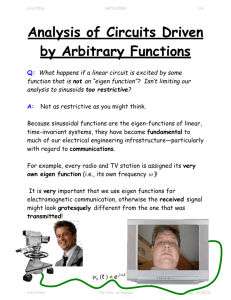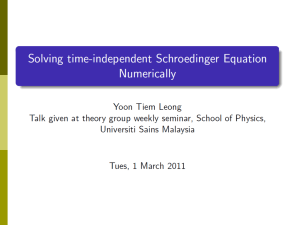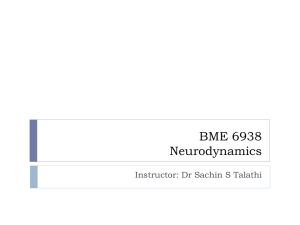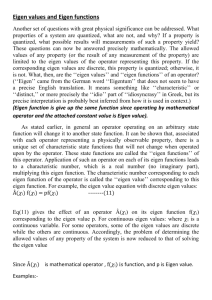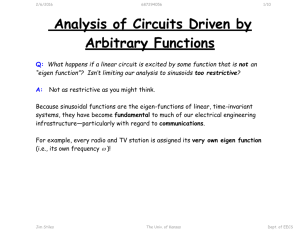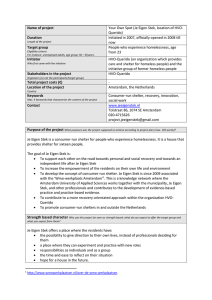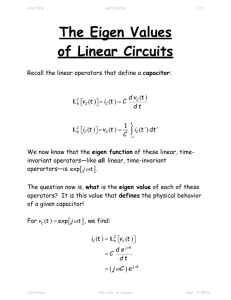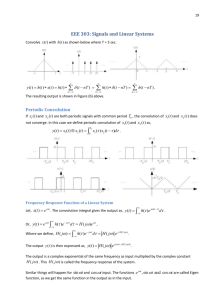PART A 1.Find the sum and product of the Eigen values of the matrix
advertisement
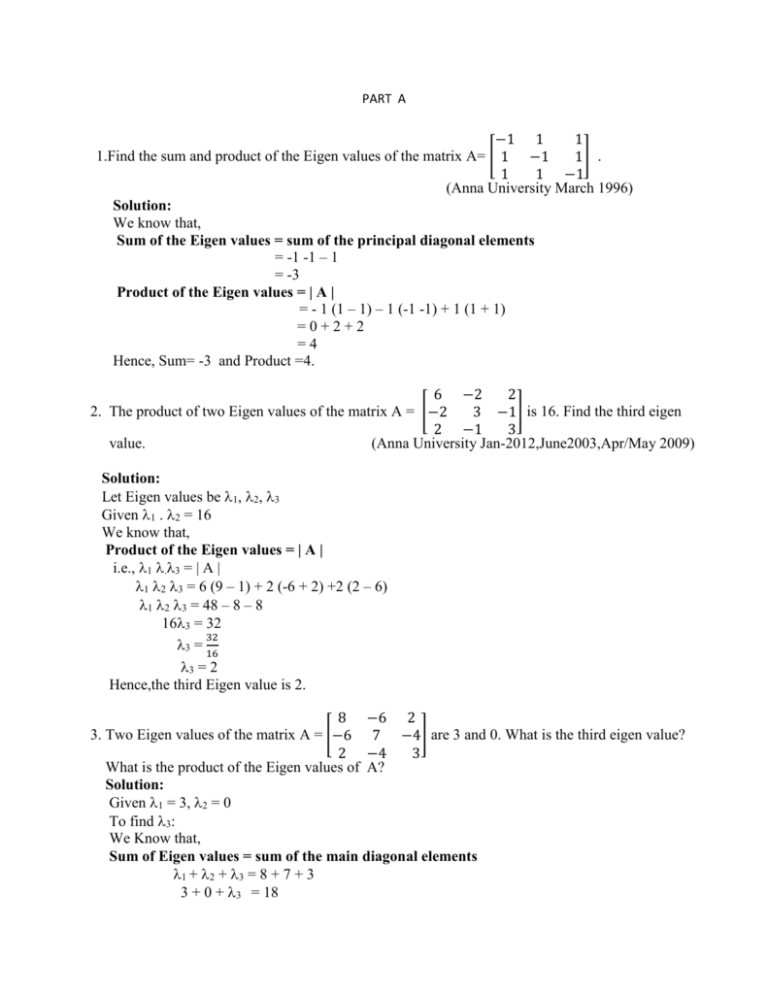
PART A −1 1 1 1.Find the sum and product of the Eigen values of the matrix A= [ 1 −1 1] . 1 1 −1 (Anna University March 1996) Solution: We know that, Sum of the Eigen values = sum of the principal diagonal elements = -1 -1 – 1 = -3 Product of the Eigen values = | A | = - 1 (1 – 1) – 1 (-1 -1) + 1 (1 + 1) =0+2+2 =4 Hence, Sum= -3 and Product =4. 6 −2 2 2. The product of two Eigen values of the matrix A = [−2 3 −1] is 16. Find the third eigen 2 −1 3 value. (Anna University Jan-2012,June2003,Apr/May 2009) Solution: Let Eigen values be 1, 2, 3 Given 1 . 2 = 16 We know that, Product of the Eigen values = | A | i.e., 1 .3 = | A | 1 2 3 = 6 (9 – 1) + 2 (-6 + 2) +2 (2 – 6) 1 2 3 = 48 – 8 – 8 163 = 32 32 3 = 16 3 = 2 Hence,the third Eigen value is 2. 8 −6 2 3. Two Eigen values of the matrix A = [−6 7 −4] are 3 and 0. What is the third eigen value? 2 −4 3 What is the product of the Eigen values of A? Solution: Given 1 = 3, 2 = 0 To find 3: We Know that, Sum of Eigen values = sum of the main diagonal elements 1 + 2 + 3 = 8 + 7 + 3 3 + 0 + 3 = 18 3 = 18 – 3 3 = 15 Product of Eigen values = 1. 2. 3 = 3 0 15 Product of Eigen values = 0 Hence the third eigen value is 15 and Product is 0. 7 4 −4 4. One of the Eigen values of [4 −8 −1] is -9. Find the other two eigen values. 4 −1 −8 Solution: Let the Eigen values 1, 2, 3 Given 1 = -9 We Know that, Sum of the Eigen values = sum of the principal diagonal elements 1 + 2 + 3 = 7 – 8 – 8 -9 + 2 + 3 = -9 2 + 3 = 0 3 = -2 ..........................(1) We Know that, Product of the Eigen values = | A | 1 23 = 7 (64 - 1) – 4 (-32 + 4) - 4(-4 + 32) -9 2 3 = 7 (63) – 4 (-28) - 4(28) 7 ×63 2 3 = −9 2 3 = -49 ......................(2) From (1) and (2) 2 (-2) = -49 −22 = -49 2 = 7 Therefore the other two eigen values are 7, -7. 3 10 5. If 2, 2, 3 are the Eigen values of A = [−2 −3 3 5 Solution: We Know that, Eigen values of A = Eigen values of AT Therefore Eigen values of AT = 2, 2, 3. 5 −4 ] find the eigen values of AT. 7 6. Prove that, a square matrix A and its transpose AT have the same Eigen values. (or) Prove that, a square matrix A and its transpose AT have the same characteristic values. Solution: Let A be a square matrix of order ‘n’ The characteristic equation of A and AT are |A - I| = 0 ................(1) And |AT - I| = 0 .................(2) Since the determinant value is unaltered by the interchange of rows and columns and |A| = |AT| Therefore, (1) and (2) are identical Hence, Eigen values of A and AT are the same. 2 7. Find the sum and product of the Eigen values of [0 0 Solution: 1 0 2 1]. 0 2 Given matrix is upper triangular matrix. We Know that, Eigen values = Main diagonal element Therefore, Eigen values are 2, 2, 2 Sum of Eigen values =2+2+2=6 Product of eigen values = 2 2 2 = 8. 8. Prove that if is an Eigen value of matrix A, then 1/ is the Eigen value of A -1 (or) If is an Eigen value of matrix A, what can you say about Eigen value of matrix A-1. Prove your statement. (Anna University-May /June 2012) Solution: If X be the Eigen vector corresponding to AX = X ....................(1) Premultiplying both sides by A -1 A -1 AX = A -1 X IX = A -1X X = A -1X 𝑋 1 It gives 1 = A -1X 𝑋 =A-1X is an Eigen values of inverse matrix A -1. 3 −1 1 9. Two of the Eigen values of A=[−1 5 −1] are 3 and 6. Find the Eigen values of A-1. 1 −1 3 (Anna University Jan/Feb 2010,Jan 2011) Solution: Let Eigen values are 1, 2, 3. Given 1 = 3, 2 = 6, 3 =? We Know that, Sum of Eigen values = sum of the main diagonal elements 1 + 2 + 3 = 3 + 5 + 3 3 + 6 + 3 = 11 3 = 11 – 9 3 = 2 1 1 1 1 2 3 Eigen values of A-1 = , , 1 1 1 = 3,6,2 . 2 10. Find the Eigen values of A-1, if the matrix A is [0 0 5 3 0 −1 2]. 4 Solution: Given matrix is upper triangular matrix. We Know that, Eigen values = main diagonal element = 2, 3, 4 Eigen values of A-1 = = 1 1 1 , , 1 2 3 1 1 1 , , . 2 3 4 3 11. If X = [ ] is the eigen vector of matrix A, find the eigen vector of A-1. 2 Solution: We Know that, Eigen Vector of the matrix A and A-1 are identical. 3 A-1 is also having the same Eigen vector [ ]. 2 12. If is an Eigen value of an orthogonal matrix then, prove that 1 is also it’s Eigen value. (Anna University Nov/Dec 2003) Solution: We Know that, A square matrix said to be orthogonal if AAT= ATA=I i.e AT = A-1 Let A be an orthogonal matrix Given is an Eigen value of A 1 is an Eigen value of A-1 Since AT = A-1 1 is an Eigen value of AT But the matrices A and AT have the same Eigen values. Since the determinants |A - I| and | AT - I| are the same. 1 Hence is also an Eigen value of A. 1 0 ) be diagonalized? Why? 0 1 13.Can A= ( (Anna University Jan 2010) Solution: The Matrix A can be diagonalized, because the eigen values of A are 1,1. When =1, the system of equation (A-I)X has infinite number of solution, i.e., we can find distinct eigen vectors for =1,1. 14. If 1 and 2 are the Eigen values of a 22 matrix A, What are the Eigen values of A2 and A-1? (Anna University May/June 2010) Solution: Given, Eigen Values of A = 1 and 2 We Know that, If the eigen values of A are 1, 2 , 3 , then the eigen values of A2 are 12, 22 , 32 and the eigen values of A-1 are 𝟏 , 𝟏 𝟏 , . 𝟏 𝟐 𝟑 Therefore, Eigen Values of A2 = 1 and 4 1 Eigen Values of A-1 = 1 and 2. 15. If sum of two Eigen values of 33 matrix A are equal to the trace of the matrix, then find the value of determinant of A. Solution: (Anna University May/June 2009) We Know that, Sum of two Eigen values = Sum of diagonal elements 1+2 = sum of diagonal elements 3=0 1 23 = 0 |A|=0 Hence, the value of the determinant is zero. 16. If the Eigen values of A are 2, 3, 4.Find the Eigen values of A-1 and Adj A. Solution: Given Eigen values of A are 2, 3, 4 We know that, Eigen values of adj A =Eigen values of Here |𝑨| |A|=234 =24 Eigen values of A-1 = 2 , 3, 1 1 1 Eigen values of adj A = |𝑨| 4 1 1 1 = 242, 243, 244 Eigen values of adj A = 12, 8, 6. 17. State Cayley-Hamilton Theorem. (Anna University May/June 2010,Jan/Feb 2010,June/July2008) Statement: Every square matrix satisfies its own characteristic equation. 18. Define Quadratic form. Solution: A homogeneous polynomial of the second degree in any number of variables is called a Quadratic form Example: 3x2+2xy+7y2 and 𝑥12 + 2𝑥22 + 4𝑥32 +6 x1x2 + 7 x1x3 + 5 x2x3 are Quadratic forms in 2 and 3 respectively. 19. Show that the Quadratic form 3𝑥12 + 3𝑥22 + 3𝑥32 +62x1x2 - 2 x2x3 is positive definite. Solution: The matrix of the Q. F is 𝑐𝑜. 𝑒𝑓𝑓 𝑥 2 Q= 1 2 1 𝑐𝑜. 𝑒𝑓𝑓 𝑥𝑦 𝑐𝑜. 𝑒𝑓𝑓 𝑦 2 𝑐𝑜. 𝑒𝑓𝑓 𝑦𝑥 1 [2 𝑐𝑜. 𝑒𝑓𝑓 𝑧𝑥 2 𝑐𝑜. 𝑒𝑓𝑓 𝑧𝑦 1 2 1 2 𝑐𝑜. 𝑒𝑓𝑓 𝑥𝑧 𝑐𝑜. 𝑒𝑓𝑓 𝑦𝑧 𝑐𝑜. 𝑒𝑓𝑓 𝑧 2 ] 3 1 1 Q= [1 3 − 1] 1 −1 3 |𝐷1 | = 3 1 |𝐷2 | =|3 |= 8 1 3 3 |𝐷3 | =|1 1 1 3 −1 1 − 1| = 3(9-1)-1(3+1)+(-1-3) 3 = 24-4-4 = 16 Here 𝐷1, 𝐷2, 𝐷3 are all positive and 𝐷𝑛 > 0 for all n. Q.F is positive definite 20. Write down the Application Of Cayley Hamilton Theorem. Solution: We can find 1. Higher integral positive power of the given square matrix 2. Inverse of the given square matrix.
